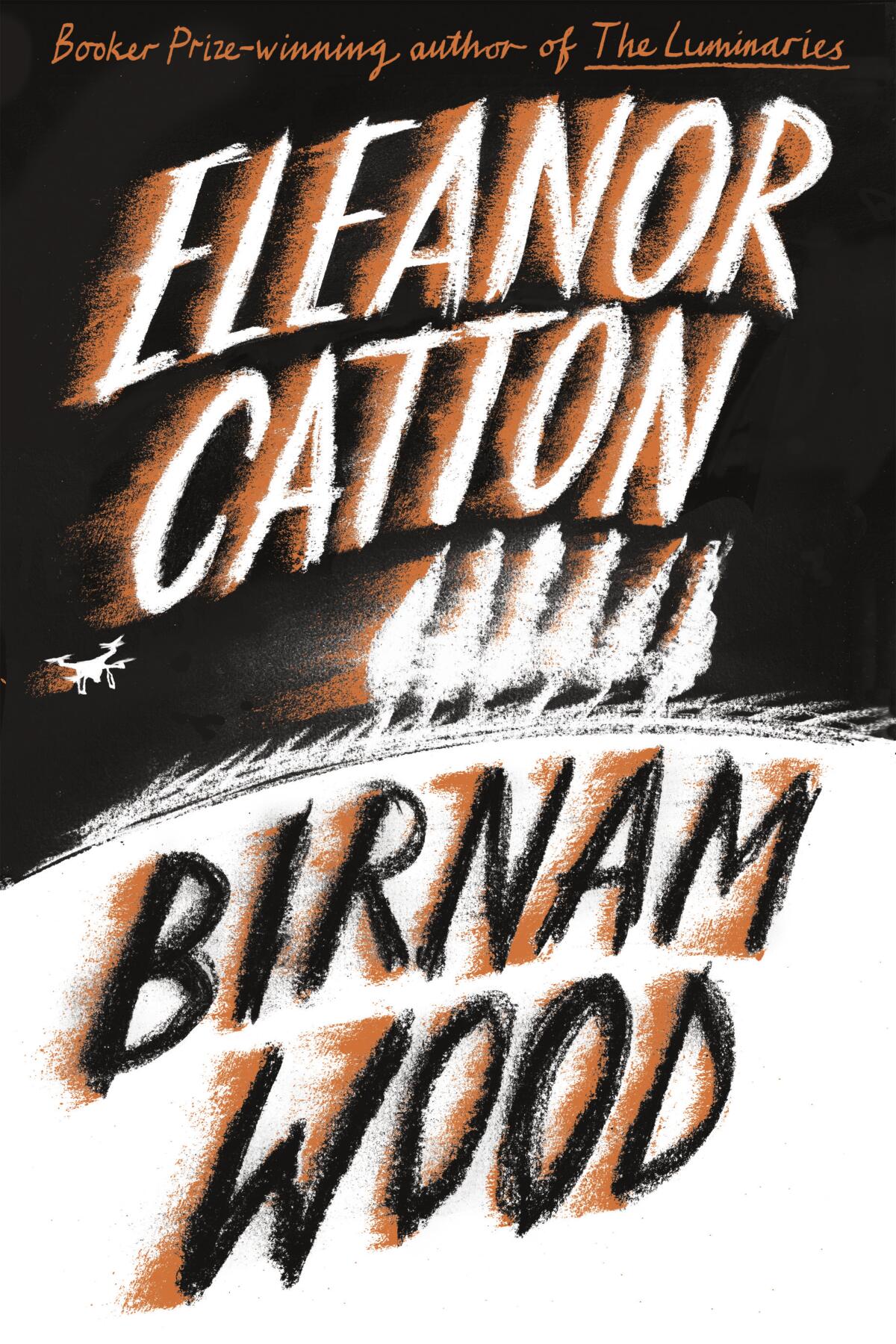Eleanor Catton follows a messy, Booker-winning novel with a tidy thriller. That’s a shame

- Share via
Review
Birnam Wood
By Eleanor Catton
FSG: 432 pages, $28
If you buy books linked on our site, The Times may earn a commission from Bookshop.org, whose fees support independent bookstores.
Neatness will kill a novel — throttle it and slowly snuff the life out of it. You know the markers: the quaintly named characters whose destinies match their monikers, the hammer-to-the-head foreshadowing, the dreaded deus ex machina. The literary thriller may borrow a few genre tropes, but in fact it is the perfect place to abandon such stodgy tools, to screw with conventions of morality and political ideology, to swirl together the various gray tones of human behavior.
And yet, not always. After the splayed-legged reach of Eleanor Catton’s Booker Prize-winning novel, “The Luminaries,” her new follow-up retracts in on itself — not just in size and scope, but in messiness too. The ragged edges are trimmed. The wonderful weirdness is flushed right out. In “Birnam Wood,” everything is exactly as it seems. The baddies are very bad, the goodies righteously torn, the speeches politically indignant or just plain hammy.
“The Luminaries” was almost baroque by comparison. It featured a cast as robust as one of those Vanity Fair Hollywood covers that unfurls into a yard-long portrait, with more and more flashily dressed characters peeking around each fold. More than a dozen protagonists jostled against one another in a colonial gold mining town in 1860s New Zealand, kicking up dust, splattering guts and digging up the earth to make its riches their own. There was a celestial rhythm to it — Catton structured the story around a particular astronomical alignment in the Southern sky from 1864-66 — and that spine held things in place while the story swerved and careened.
Eleanor Catton spent more time adapting her book ‘The Luminaries’ for TV than she did writing it in the first place. She details the process for The Times.
“Birnam Wood” has a slightly more demure premise, although its characters are just as concerned with the fortune-making yields of New Zealand’s magnificent rocks and soil. A guerrilla gardening group named Birnam Wood (in some oblique conjunction with the famous marching forest in “Macbeth”) has been planting its crops on roadsides and unloved plots for years, barely making ends meet, let alone fomenting revolutionary change.
Then its nominal leader, Mira Bunting, meets enigmatic billionaire Robert Lemoine — founder of Autonomo, a nefarious surveillance corporation — while scouting a vast property adjacent to a national forest for its potential as the group’s next planting ground. Lemoine has recently weaseled his way into ownership of the land and has his own designs on it, but he tells Mira he’ll invest a hundred grand in Birnam Wood to bolster the group’s mission — and, he admits, help himself secure New Zealand citizenship and build a survivalist bunker.
The bunker is bunk: Lemoine is actually mining a rare mineral that, if successfully unearthed, will make him “by several orders of magnitude, the richest person who had ever lived.” Not just richer, but the richest. Superlatives reign supreme in “Birnam Wood.”

He is a figure closer to Lex Luthor than PayPal founder and libertarian menace Peter Thiel, who bought himself New Zealand citizenship and whom Catton has cited as a model. Lemoine is a supervillain in the least subtle sense, with near-infinite money, insuperable technology and maniacal plans for a grandiose world takeover. Just give him a lair and a cackle already.
Before his first encounter with Mira, Lemoine intercepts her phone’s signal and hacks her data, turning the cell into his personal plaything. He can monitor her texts and browsing, trace her whereabouts and impersonate her in texts — the kind of superpower that saps all the fun out of their David-and-Goliath relationship. His financial supply is seemingly all liquid. He repositions drones like “24’s” Jack Bauer and employs former special ops commandos who have all the autonomy of “Star Wars” Stormtroopers. When an accidental death pulls Mira even further under his sway, Lemoine pushes the plot even further into the absurd.
Catton writes him in big block letters: VILLAIN. And she narrates in a close third-person, explaining motivations down to the atom and shutting off any avenue of curiosity her characters might have about themselves. Lemoine admits that he “loved to present as an enigma” (what billionaire doesn’t?), that “it made his self-dissections all the sweeter to know that he was outwardly inscrutable, a puzzle to which only he would ever hold the key.” And yet, “there was a key. There was a secret to his nature, a clue that explained everything about him, a single eight-week period in his very early adolescence that had forged, in every way, the man that he’d become.” It won’t surprise you to learn that the “key” is a childhood trauma — and it involves both the CIA and a withholding daddy.
Max Chafkin’s biography, “The Contrarian: Peter Thiel and Silicon Valley’s Pursuit of Power,” sheds light on the secretive, problematic tech mogul.
Lemoine is the fixed point in a loveless triangle; moving the trio into more acute or obtuse positions are headstrong but guileless Mira and her erstwhile romantic interest Tony Gallo, a former Birnam Wood member with a weighty chip on his shoulder and delusions of journalistic grandeur. Both are eminently self-assured and foolish to the point of ridiculousness.
Catton’s big theme is plunder, and her millennial crusaders are as fervent in their protection of New Zealand’s resources as Lemoine is determined to dynamite and exploit them. Though their prose styles dance to very different rhythms, Catton has a Sally Rooney-ish determination to adorn her characters in their political mantras, particularly lefty millennial do-gooderism. The gardeners use the name of one member’s mother as “a kind of shorthand for the many evils of the baby-boomer generation, a despised cohort of hoarders and plunderers.”
At a Birnam Wood hui (i.e., a gathering — a term the gardeners have lifted somewhat warily from the Māori), Tony launches into a tirade against the group’s ideological weakness, bleating at them for nine pages about “the relationship as the base socio-economic unit,” the joylessness of the political left and how “nobody’s willing to use the language of morality any more.” He eventually stomps out and heads into the forest around Lemoine’s land to investigate what the billionaire is up to and “to prove to himself that he was not just yet another Marxist intellectual cliché.” He is, and Catton knows it. But the problem isn’t cliché; it’s politics as a substitute for personality.
Tony is the crusading truth-seeker, Mira the naive do-gooder. For all Catton’s rigorous psychologizing, the characters never step out of their frameworks to become people. After Tony takes to the woods and Mira ends up enmeshed in a cover-up, “Birnam Wood” makes an even harder shift into the absurd. The novel splits its pants — its concerns earthly but its outcomes stratospheric, its devices outlandish but its plot twists baldly predictable.
Rooney’s ballyhooed third novel, “Beautiful World, Where Are You,” has it out over whether Sally Rooney deserves to write bestselling fiction.
Sure, by the end of “Birnam Wood” there are real, bloody consequences — a muddle of flesh and bone. It’s messy, at last, but not quite the mess a novel needs. Guns, one character points out, are hardly ever carried in New Zealand, and yet bullets whiz through the novel’s final pages as though Robert Ludlum stepped in as Catton’s co-writer. Characters are discarded with a shrug, like early victims in a horror movie.
And what’s a critic to do with a melodramatic ending that can’t be spoiled but perfectly encapsulates the novel’s primary flaw? Let’s put it this way: If “Birnam Wood” were a film (and it just might end up as one) its final minutes would feature a slo-mo crawl, a soaring score, a sacrifice for the greater good. Neat and tidy, as if someone took a stiff broom to the plot and swept out all the delightfully dirty corners.
Kelly’s work has been published in New York magazine, Vogue, the New York Times Book Review and elsewhere.
More to Read
Sign up for our Book Club newsletter
Get the latest news, events and more from the Los Angeles Times Book Club, and help us get L.A. reading and talking.
You may occasionally receive promotional content from the Los Angeles Times.











